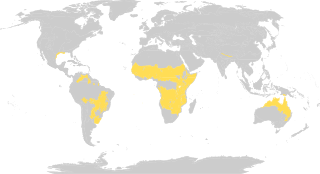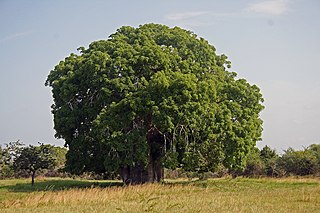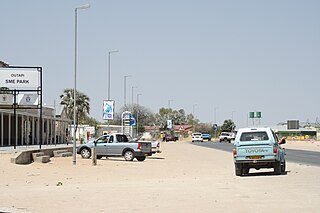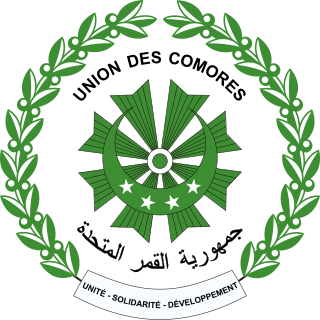
Tropical and subtropical grasslands, savannas, and shrublands is a terrestrial habitat type defined by the World Wide Fund for Nature.. The biome is dominated by grass and/or shrubs located in semi-arid to semi-humid climate regions of subtropical and tropical latitudes.

Adansonia is a genus of deciduous trees known as baobabs. They are found in arid regions of Madagascar, mainland Africa, Arabia, and Australia. The generic name honours Michel Adanson, the French naturalist and explorer who described Adansonia digitata.

The Order of the Baobab is a South African civilian national honour, awarded to those for service in business and the economy; science, medicine, and for technological innovation; and community service. It was instituted on 6 December 2002, and is awarded annually by the President of South Africa. The order is named after the baobab tree, which was chosen as a symbol because of its endurance and tolerance, its vitality, its importance in agro-forestry systems, and its use as a meeting place in traditional African societies.

Morondava [murunˈdav̥] is a city located in Menabe Region, of which it is the capital, in Madagascar. It is located in the delta of the Morandava River at 20°17′5″S 44°19′3″E.

Adansonia digitata, the baobab, is the most widespread tree species of the genus Adansonia, the baobabs, and is native to the African continent. The long-lived pachycauls are typically found in dry, hot savannahs of sub-Saharan Africa, where they dominate the landscape, and reveal the presence of a watercourse from afar. Their growth rate is determined by ground water or rainfall, and their maximum age, which is subject to much conjecture, seems to be in the order of 1,500 years. They have traditionally been valued as sources of food, water, health remedies or places of shelter and are steeped in legend and superstition. European explorers of old were inclined to carve their names on baobabs, and many are defaced by modern graffiti.

Nxai Pan National Park is a national park in north-eastern Botswana, consisting of Nxai Pan, which is one of the Makgadikgadi Pan salt flats. Nxai Pan National Park lies just north of the Maun-Nata main road and adjoins Makgadikgadi Pans National Park on its northern border. The pan itself is a fossil lakebed about 40 square km in size.

Outapi wa Nakafingo na Temba, also Outapi or Uutapi and Ombalantu, is a town in northern Namibia near the border with Angola situated 90 km (56 mi) northwest of Oshakati. It is the capital of Omusati region and the district capital of the Outapi electoral constituency. The language spoken there is Oshiwambo.

Diourbel Department is one of the 45 departments of Senegal, one of the three constituting the Diourbel Region.

Adansonia grandidieri, sometimes known as Grandidier's baobab, is the biggest and most famous of Madagascar's six species of baobabs. This imposing and unusual tree is endemic to the island of Madagascar, where it is an endangered species threatened by the encroachment of agricultural land.
Production Baobab is a voice actor talent management firm in Shinjuku, Tokyo, Japan.

The coat of arms of Senegal is the heraldic device consisting of a shield charged with a lion on the left half and a baobab tree on the right, flanked by palm branches and topped with a five-pointed green star at the top.

The Parijaat tree is a sacred baobab tree in the village of Kintoor, near Barabanki, Uttar Pradesh, India, about which there are several legends.

The Avenue of the Baobabs, or Alley of the Baobabs, is a prominent group of Grandidier's baobabs lining the dirt road between Morondava and Belon'i Tsiribihina in the Menabe region of western Madagascar. Its striking landscape draws travelers from around the world, making it one of the most visited locations in the region. It has been a center of local conservation efforts, and was granted temporary protected status in July 2007 by the Ministry of Environment, Water and Forests—a step towards making it Madagascar's first natural monument.

Burkinabé cuisine, the cuisine of Burkina Faso, is similar to the cuisines in many parts of West Africa, and is based on staple foods of sorghum, millet, rice, fonio, maize, peanuts, potatoes, beans, yams and okra. Rice, maize and millet are the most commonly eaten grains. Grilled meat is common, particularly mutton, goat, beef and fish. Vegetables include, besides yams and potatoes, okra, tomatoes, zucchini, carrots, leeks, onions, beets, pumpkins, cucumbers, cabbage, sorrel and spinach. Although imported products are becoming more common in urban areas, meals in more rural areas typically consist of tô, a sauce of corchorus or baobab leaves, as well as the calyx from Bombax costatum, dried fish, and spices such as chili and soumbala.

Parliamentary elections were held in the Comoros on 6 December 2009, with a second round on 20 December. The elections were originally scheduled for July 2009, but were postponed until after a constitutional referendum was held in May 2009. They were then scheduled to take place on 29 November, but were delayed again. The result was a victory for the Baobab Movement, a coalition supporting President Ahmed Abdallah Mohamed Sambi.

Gweta is a small village in Botswana. It lies about 205 kilometres (127 mi) away from Maun and about 100 kilometres (62 mi) from Nata.

Mali cuisine includes rice and millet as staples of Mali, a food culture heavily based on cereal grains. Grains are generally prepared with sauces made from edible leaves, such as sweet potato or baobab, with tomato peanut sauce. The dishes may be accompanied by pieces of grilled meat.
Operation Maple was a series of World War II operations in Italy in support of the Anzio landings. It comprised operations by the British Special Air Service, starting on 7 January 1944. Thistledown was successful but Driftwood failed and its objective had to be destroyed later by Operation Baobab. None of the members of the first two parties returned safely, either being captured or going missing.
Beyond The Ice Limit is a techno-thriller novel by American authors Douglas Preston and Lincoln Child. The book is a sequel to their 2000 book The Ice Limit and was published on May 17, 2016 by Grand Central Publishing. It is the fourth book in Preston and Child's Gideon Crew series.

















